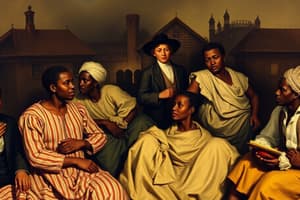Podcast
Questions and Answers
What event is cited as a significant turning point that hinted at deeper regional divisions over slavery in the South?
What event is cited as a significant turning point that hinted at deeper regional divisions over slavery in the South?
- The Hartford Convention
- The Admission of Missouri (correct)
- The Constitutional Convention
- The War of 1812
Which of the following crops was identified as the most important economic driver in the South by the 1850s?
Which of the following crops was identified as the most important economic driver in the South by the 1850s?
- Rice
- Tobacco
- Indigo
- Cotton (correct)
What geographical feature contributed significantly to the agricultural success of the South?
What geographical feature contributed significantly to the agricultural success of the South?
- Navigable waterways (correct)
- Arid climate
- Volcanic soil
- Mountainous terrain
Which of the following factors contributed to the South's economic reliance on slavery?
Which of the following factors contributed to the South's economic reliance on slavery?
What characteristic of Southern climate was emphasized as both beneficial and detrimental?
What characteristic of Southern climate was emphasized as both beneficial and detrimental?
Study Notes
The Rise of the South
-
The text explores the historical development of the American South as a distinct region, emphasizing the influence of its unique economic and social conditions.
-
The South’s economic foundation was built on commercial agriculture, especially cash crops like cotton, tobacco, rice, sugar, and indigo.
-
By the 1850s, cotton constituted two-thirds of U.S. exports, linking the South to the global market.
-
The cultivation of these crops required vast tracts of land and an abundance of cheap, unskilled labor, leading to the expansion of the plantation system and the institution of slavery.
The Southern Identity
-
The South’s climate and geography contributed to its self-contained nature.
-
Unlike the North, the South did not experience significant immigration from Europe, resulting in a more homogeneous population and a stronger sense of regional identity.
-
The South’s dependence on slave labor reinforced its cultural distinctiveness.
-
The South developed a unique "biracial" society marked by stark disparities in power and status but also intertwined cultural exchange.
Diverse Perspectives on the Old South
-
The Old South is often portrayed through contrasting lenses: a romanticized view of a graceful, aristocratic society (as seen in "Gone with the Wind") and a harsher depiction of brutality and dehumanization (as presented in "Uncle Tom's Cabin").
-
Historians like Eugene Genovese and Elizabeth Fox-Genovese explore the complex paradox of how a region could possess both noble and cruel facets.
-
Mark Twain, in his characteristically provocative style, argued that the South’s romanticized vision of a medieval society, influenced by works like Sir Walter Scott’s "Ivanhoe," contributed to the Civil War.
The Peculiar Institution and its Justification
-
The centrality of slavery to Southern society made it impossible to understand southern culture without considering the experiences of Black Southerners.
-
The South’s reliance on slavery led to the development of the "proslavery" argument, which sought to justify slavery as a positive institution, challenging the prevailing ideology of equality.
-
Some proponents of slavery, like George Fitzhugh, argued that the paternalism of slavery was superior to the exploitative "wage slavery" of the North's capitalist system.
Studying That Suits You
Use AI to generate personalized quizzes and flashcards to suit your learning preferences.




